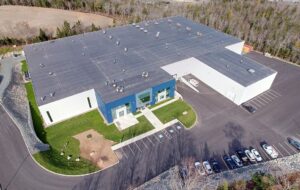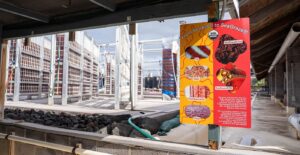Editor’s Note: Chris Powers is an entrepreneur, writer, and urban agriculture evangelist who is on a mission to grow and promote environmental technologies. Here he offers his four key takeaways from the Association for Vertical Farming’s Summit in Amsterdam two weeks ago.
You can follow Chris’s work by signing up for his email list.
Last week marked a watershed moment for vertical farming with the Association for Vertical Farming’s (AVF) Summit in Amsterdam. The AVF Summit brought together 275+ attendees and 20 speakers and panelists to collaborate on developing vertical farming as a profitable and sustainable industry.
I had the chance to attend the event from the front lines and backstage as a volunteer. There I learned more about vertical farming and sustainability than I have in the past year of connecting with entrepreneurs and reading articles, combined. I want to share a few valuable insights that I gained from the event that relate specifically to entrepreneurs and ag investors interested in vertical farming and urban agriculture.
Here are my four key takeaways from the Summit, which this year focused on Circular Economy & True Sustainability.
The State of Vertical Farming
Howard Brin, chief operating officer of the AVF presented a few high-level findings from an exhaustive industry research study conducted by the association. The white paper is slated for release in early July and will cover topics including: regional developments in key markets, architecture and urban rules, education, finance and business models, biopharming and medical plants in Controlled Environment Agriculture (CEA) and more.
As it stands, most businesses are selling microgreens to high-end restaurants or fresh salad greens to retail stores. Some other untapped, high margin opportunities include selling direct to consumers, vertically integrating an established consumer packaged goods (CPG) food supply chain, and using vertical farms to produce biologically active molecules for novel medicinal applications. In spite of these opportunities, there are still many outsiders asking if it’s possible and the answer is yes.
The Technology Is Ready, Now
The speakers, panelists, equipment companies, industry consultants, and even small farmers agree that ‘the technology is already here.’ There are successful and profitable companies in vertical farming and CEA today, unlike a few years ago when vertical farming was an unreliable business and mainly operating on a research and development scale. Today, it is a technical and business reality due to the emergence of higher efficiency LED lighting, low cost sensing and data collection, along with a growing knowledge base of applied hydroponics technology for food production.
Moving forward we need more entrepreneurs to start companies with investor support along with training for more skilled workers to begin developing the growth of vertical farming. As the industry continues to grow there will be a need for master growers, plant scientists, engineers trained to design and implement high tech grow systems, and more. The demand for skilled workers will create future opportunities for education and training in the field.
The Known Unknown: It’s Crucial to Avoid Costly Mistakes Early
Although the technology is ready, there are still significant risks with entering this industry. Vertical farming, though profitable, is a capital intensive business with a lot of variables specific to the markets that growers hope to operate in. During several conversations with business owners, I realized that there are ways to mitigate some of these risks, such as investing in a feasibility study.
Talking to the teams at Blue Planet Consulting, Indoor Harvest, and a few others, I realized that there are a lot of hidden costs associated with becoming an independent grow operation.
Here are some hidden costs associated with setting up a vertical farm:
- Regulatory barriers.
- Not understanding input costs for growing (power, fertilizer, waste, etc.)
- Having a mismatch between different pieces of equipment.
- Not selecting profitable crops to support your initial capital costs.
- Knowing whether to diversify or focus on the low hanging fruit (i.e. microgreens.)
- Going into the wrong market.
- Being oversold on a particular equipment vendor’s promises for yield and turn around time on harvests.
- Equipment maintenance.
- Legal expenses.
- Hiring and maintaining high quality growers.
Working with industry consultants who can account for these costs up-front is one way for entrepreneurs to avoid critical errors that can hamstring a business during execution. It is important for investors to consider the above points with due diligence before plunging capital investment into new ventures in vertical farming.
We Need To Be Leaders To Make Vertical Farming Truly Sustainable
The business models are quickly developing to make this industry profitable, but we must remember why vertical farming was conceived in the first place.
Vertical farming creates highly controlled growing climates and new possibilities for improving the food supply chain. These technologies are creating opportunities for places like Japan and Singapore to secure their food supply, while helping China and the USA with food safety issues. Vertical farming also has the potential to be less environmentally intensive in a lot of ways.
Growing food at the point of consumption, in other words net-zero distribution, cuts out fossil fuels by saving food miles. Vertical farming also reduces water and fertilizer inputs significantly while also requiring no chemical pesticides or herbicides. Lastly, vertical farming is a hedge against climate change since it is not impacted by extreme weather events.
Technology, however, is morally neutral. Since vertical farms use artificial light and climate controls, the source of electricity is crucial for reducing the carbon footprint per unit of food harvested. Here is an in-depth explanation of the environmental limitations of growing indoors.
In order to overcome the faux-sustainability propaganda sometimes called ‘greenwashing,’ we have to look at the real impact of each farm objectively. It’s imperative that we continue to innovate in order to make vertical farming a truly sustainable industry. The AVF is working on a sustainability certification scheme in order to standardize the way that we measure a vertical farm’s environmental and social impact. For those of you interested in impact investing, the true environmental cost of a grow operation is important to consider.
Closing Thoughts
I was impressed by the culture of openness and innovation that I found at the AVF Summit. The community as a whole wants to see farmers be more successful. That speaks to the vision of industry collaboration the AVF has created.
It’s important for us to work together to help new vertical farms become successful. If they start failing or sacrificing environmental principles in exchange for short-term profits, then they will be less likely to procure the kind of investment that we need to solve big problems with our food supply chain.
Want to learn more?
Keep your eyes on the AVF’s Youtube Channel. Soon the entire AVF Summit will be uploaded for your viewing. Go to the AVF website and sign up for their newsletter. If you become a business or institution member of the AVF you’ll get access to the white paper when it is released early in July.
To continue inspiring the current and next generation of vertical farmers, in mid-2017 the AVF Summit will be held in New York City.
If you have any specific questions please feel free to contact me.




